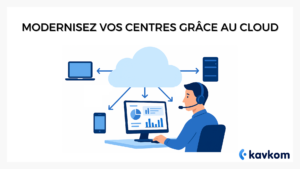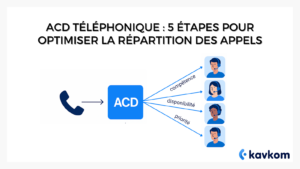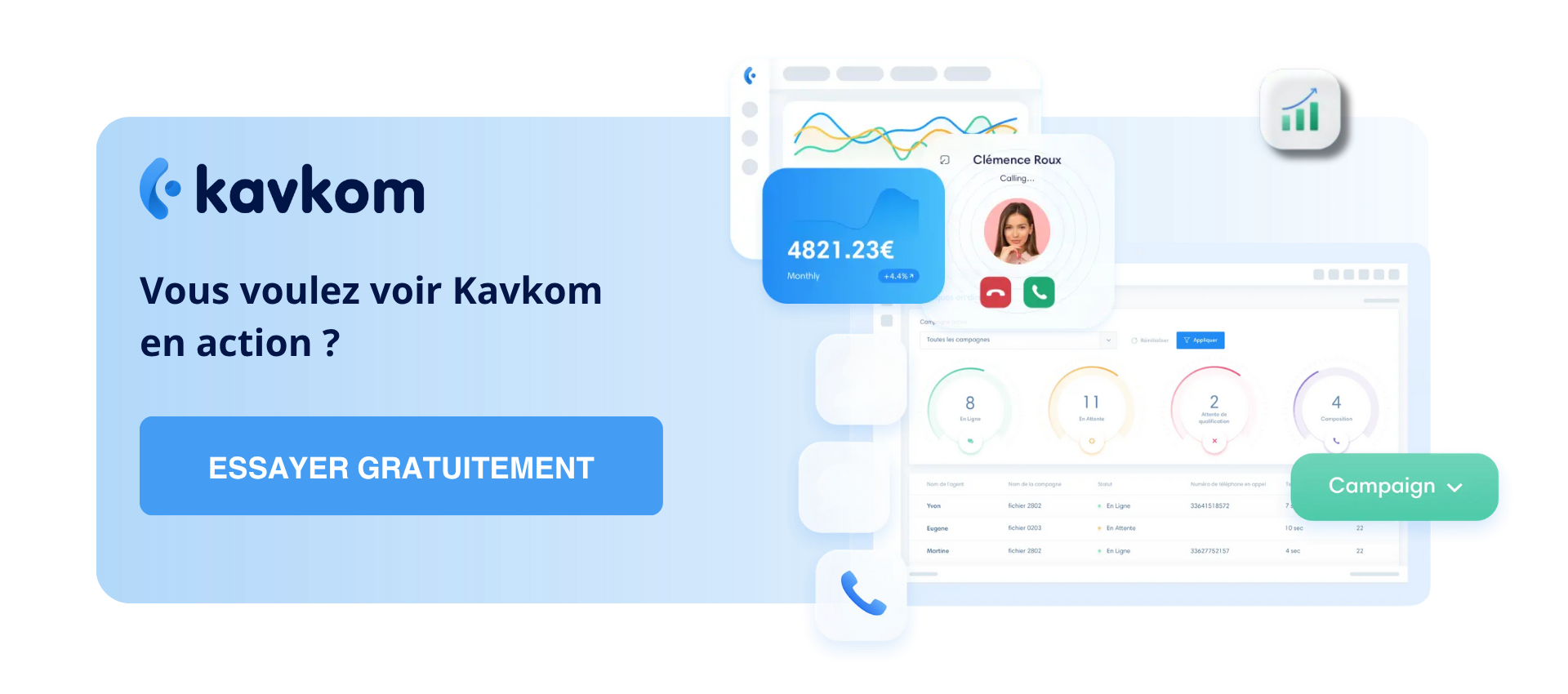Definition and role of call center software
Call center software is much more than just a telephony tool. It’s a complete, integrated solution designed to efficiently manage all customer communications, whether inbound or outbound.
Unlike a standard telephony solution, call center software offers advanced features specifically adapted to the needs of modern contact centers.
At the heart of these systems is the ability to centralize and optimize customer relationship management. Thanks to features such as intelligent call routing, automatic call distribution, and integration with CRM systems, these software packages enable companies to handle large volumes of customer interactions in an efficient, personalized way.
The importance of call center software in managing customer communications cannot be overstated. Not only does it improve agent productivity by automating repetitive tasks, it also delivers a consistent, high-quality customer experience across all communication channels. Whether by telephone, e-mail, live chat or social networks, good call center software ensures smooth, unified management of all interactions.
In short, call center software is the technological backbone that enables companies to transform their customer service department from a mere cost center into a true profit and customer loyalty center.
Call center evolution: from the telephone to the cloud
The history of call centers reflects the rapid evolution of communications technologies.
In their early days, call centers relied on analog telephone systems, limited in capacity and functionality. Agents worked from fixed terminals, and call handling was largely manual.
The advent of digital telephony marked a first turning point, enabling better call quality and the introduction of features such as queuing and basic routing. However, the real revolution came with the emergence of cloud-based solutions.
Cloud call center software has transformed the landscape, offering unprecedented flexibility and scalability. These solutions enable businesses of all sizes to access advanced functionality without massive infrastructure investment. The cloud has also made it possible for agents to work remotely, a crucial advantage highlighted by recent world events.
Modern solutions offer many advantages over traditional systems:
- Flexibility: Cloud systems adapt quickly to fluctuations in call volume.
- Cost: Pay-as-you-go pricing model, reducing initial costs.
- Integration: Easy integration with other tools such as CRM or e-commerce platforms.
- Automatic updates: the latest functionalities are always available without the need for extensive IT intervention.
- Accessibility: Agents can work from anywhere with an Internet connection.
This move to the cloud has democratized access to cutting-edge call center technologies, enabling even small businesses to compete with the big boys in the customer experience arena.
The impact of call center software on the customer experience
Modern call center software has revolutionized the customer experience, transforming potentially frustrating interactions into opportunities for satisfaction and loyalty. Their impact can be measured on several levels:
- Greater personalization: Thanks to CRM integration, agents have access to the customer’s complete history right from the start of the interaction. This enables a personalized approach, where the agent can see the customer’s profile and adapt his response accordingly.
- Reduced waiting times : Intelligent routing directs calls to the most qualified agent available, dramatically reducing waiting times and unnecessary transfers.
The power of Kavkom’s Robot Dialer lets you call up to 150,000 calls per hour and campaign. - Omnichannel consistency: Customers can switch from one channel to another (phone, email, chat, social networks) without loss of context, offering a fluid, consistent experience.
- First contact resolution : With decision-support tools and access to comprehensive knowledge bases, agents are better equipped to resolve problems at first contact.
Impressive statistics show that call center performance has improved thanks to this software:
- According to a Forrester study, companies using advanced call center software have seen a 25% increase in customer satisfaction.
- A McKinsey survey reveals that call centers using AI and real-time analytics have reduced their processing times by 40% while increasing first-call resolution by 15%.
- Gartner reports that companies integrating an omnichannel approach see a 35% increase in their customer retention rate.
These figures underline the considerable impact of call center software on customer service quality, loyalty and, ultimately, company growth.
By investing in these technologies, organizations don’t just improve their operational efficiency; they build a sustainable competitive advantage based on customer service excellence.
Essential features of modern call center software
High-performance call center software is distinguished by a set of key features that optimize customer interaction management and improve operational efficiency. Here are the essential components to look for:
- Incoming and outgoing call management :
- Intelligent routing Automatically routes calls to the most qualified agent based on predefined criteria.
- Advanced queue Efficiently manage call peaks with reminder and estimated waiting time options.
- Automatic Call Distribution (ACD) Optimizes call distribution to balance agents’ workloads.
- Outbound call management: Facilitate prospecting campaigns with predictive dialing and preview features.
- CRM integration and customization :
- Real-time synchronization with CRM Provides a 360° view of the customer for immediate personalized interaction.
- Unified customer history Centralize all past interactions, whatever the channel used.
- Customize scripts: adapt dialogs to customer profile and history.
- Productivity tools for agents :
- Click-to-call Allows calls to be made directly from the software interface or CRM.
- Dynamic scripts Guide agents through structured conversations, adaptable in real time.
- Integrated task management: makes it easy to track post-call actions and commitments to customers.
- Real-time analysis and reporting :
- Customizable dashboardss : Real-time visualization of key KPIs (waiting time, resolution rate, customer satisfaction, etc.).
- Predictive analysis Predictive analysis: Anticipate call peaks and optimize resource planning.
- Call recording and evaluation Training: Facilitates agent training and continuous improvement.
These features, combined in a modern contact center solution, not only improve operational efficiency, but also deliver a superior customer experience.
They transform the call center from a simple point of contact into a true customer engagement hub, capable of handling complex interactions across all communication channels.
Emerging technologies in call center software
Rapidly evolving technologies are continually transforming the call center software landscape.
Here are the key innovations that are redefining customer experience and operational efficiency:
- Artificial intelligence and chatbots : AI revolutionizes call routing by analyzing the caller’s context and intent for more precise distribution. Chatbots, meanwhile, efficiently handle simple requests, freeing up agents for more complex tasks. For example, a chatbot can handle up to 80% of first-level requests, considerably reducing the volume of calls to human agents.
- Voice analysis and customer sentiment : Real-time voice analysis technologies can assess the caller’s tone, rhythm and emotions. This analysis provides valuable insights into immediate customer satisfaction, and helps identify situations requiring rapid escalation. Supervisors can use this data for targeted agent training, continuously improving service quality.
- Omnichannel and social media integration: The omnichannel approach is now a must in modern customer service. It enables a seamless transition between channels (phone, email, chat, social networks) while maintaining the context of the interaction.
Integrating social media, including LinkedIn for B2B interactions, into the call center workflow enables rapid response to brand mentions and effective online reputation management.
Strategies for integrating social media :
- Real-time monitoring of brand mentions
- Automatic routing of social messages to the appropriate agents
- Sentiment analysis on social platforms to anticipate problems
These emerging technologies don’t just improve efficiency; they fundamentally transform the nature of customer interactions. They enable advanced personalization, faster problem resolution and a deeper understanding of customer needs and expectations.
To remain competitive, companies must not only adopt these technologies, but also integrate them strategically into their overall approach to customer service.
Selecting the right call center software for your business
Choosing the right call center software for your business is crucial to optimizing your customer service. Here’s a guide to help you through the selection process:
- Assessment of your company’s specific needs:
- Analyze your call volume, interaction types and business objectives.
- Consider the size of your team and your growth projections.
- Identify the necessary integrations with your existing systems (CRM, ERP, etc.).
Checklist of features to consider :
- Intelligent call routing
- CRM integration
- Analysis and reporting tools
- Multi-channel support (phone, email, chat, social networks)
- Advanced computer telephony features
- Comparison of cloud vs. on-premise solutions :
Cloud :
- Flexibility and scalability
- Lower initial costs
- Automatic updates
- Dependence on Internet connection
On-premise :
- Total control over data
- Extensive customization
- High initial costs
- IT maintenance required
- Budgetary considerations and ROI :
- Compare pricing models (per seat, per use, etc.).
- Calculate the TCO (Total Cost of Ownership) over 3-5 years.
- Estimate ROI by considering gains in efficiency, customer satisfaction and retention.
- Supplier evaluation and demonstrations :
- Request personalized demos and free trials.
- Evaluate the ease of use for your agents.
- Check out the support and training options available.
Key questions to ask suppliers :
- What is the guaranteed availability of your service?
- How do you manage data security and compliance?
- What are your integration options with our current CRM?
- What is your development plan for new features?
- Can you provide customer references in our sector?
By following this guide, you’ll be able to select call center software that not only meets your current needs, but will also grow with your business.
Remember, the right choice can transform your call center into a real engine of growth and customer satisfaction.
Implementation and optimization of your call center software
Once you’ve selected your call center solution, implementation and optimization are crucial to maximize its potential. Here’s a step-by-step guide to ensure a smooth transition and optimal use:
Planning and deployment
- Set a realistic timetable, generally allowing 2-3 months for full implementation.
- Involve all stakeholders, including IT, sales and end-users.
- Configure the interface for ease of use and to suit your specific requirements.
Agent training and team adoption
- Organize comprehensive training sessions, using videos and practical guides.
- Set up a mentoring system where experienced employees assist new ones.
- Create an easy-to-understand dashboard so that each agent can see his or her performance profile.
Integration with existing systems
- Ensure seamless integration with your CRM (Salesforce, Zendesk, HubSpot, Zoho, Microsoft Dynamics).
- Configure connectors to synchronize customer data and call history.
- Rigorously test integration to ensure that information is displayed correctly in each system.
Continuous optimization and performance measurement
- Use integrated analysis tools to track key KPIs (waiting time, resolution rate, customer satisfaction).
- Implement a continuous improvement process based on agent feedback and usage data.
- Update regularly to benefit from new features and security enhancements.
Tips for successful implementation :
- Customize your IVR (Interactive Voice Response) to effectively redirect callers.
- Use the “click-to-call” function on your website to make it easier for prospects to contact you.
- Leverage omnichannel capabilities to deliver a consistent customer experience across all channels.
- Take advantage of cloud-based solutions for greater flexibility and automatic updates.
Budgetary considerations :
- Prices vary considerably, from a few dozen euros per month per user for solutions like Aircall, to several thousand euros for more advanced enterprise systems.
- Compare prices taking into account the total cost of ownership, including support and customization costs.
By following these steps and remaining attentive to the needs of your teams and customers, you can transform your call center into a powerful customer engagement tool.
Don’t forget that optimization is an ongoing process – stay on top of new trends and feedback from your users to maintain your competitive edge.
The future of call center software
Rapidly evolving technologies continue to shape the future of call center software, offering ever more innovative possibilities for optimizing customer service. Here’s a look at emerging trends and predictions for 2025 and beyond:
- Ubiquitous artificial intelligence :
- Advanced virtual assistants capable of handling complex interactions
- Predictive analysis to anticipate customer needs before they even call
- Hyper-personalized routing based on complete customer history and behavioral profile
- Seamless, unified customer experience:
- Full integration between call center solutions and leading CRM suites such as Salesforce, Zendesk, and HubSpot
- Fluid transition between channels (phone, chat, email, social networks) with context retention
- Adaptive user interfaces that automatically adjust to each agent’s preferences
- Advanced automation and intelligent self-service:
- Conversational bots capable of resolving the majority of queries without human intervention
- Next-generation interactive voice response (IVR) systems using natural language processing
- AI-powered self-service customer portals, significantly reducing call volumes
- Real-time analysis and continuous optimization:
- Dynamic dashboards providing a 360° view of call center activity
- Real-time voice analysis tools to assess customer satisfaction during the call
- Machine learning systems for continuous optimization of scripts and processes
- Native and hyper-flexible cloud solutions:
- Fully cloud-based architectures for instant scalability
- Plug-and-play integrations with a wide range of third-party tools
- Extensive customization without the need for advanced technical skills
- Enhanced security and compliance :
- End-to-end encryption for all exchanges, including telephone calls
- Automated compliance with ever-changing regulations (RGPD, CCPA, etc.)
- Biometric authentication for enhanced customer data security
- Virtual and decentralized contact centers :
- Fully paperless solutions, without physical infrastructure
- Advanced collaboration tools for distributed teams
- Performance management and remote coaching with augmented reality
These advances promise to radically transform the customer experience and operational efficiency of call centers.
Companies that adopt these emerging technologies will be able to deliver exceptional customer service, while optimizing costs and improving team satisfaction.
To remain competitive, organizations will need to adopt a flexible, forward-looking strategy, investing in scalable solutions that can rapidly adapt to technological change and rising customer expectations.
Transform your customer service with the right call center software
In conclusion, the adoption of modern, high-performance call center software has become a must for companies keen to deliver an exceptional customer experience. These solutions, often cloud-based, not only optimize telephone activity, but also deliver a consistent, personalized omnichannel approach.
Let’s summarize the key points:
- Modern call center software offers much more than just call management. It makes it easy to display customer information, personalize every interaction, and use advanced features for optimized support.
- The omnichannel approach, integrating phone, email, chat and social networks, is essential to meet the expectations of today’s customers.
- Integration with CRM and other professional tools provides a 360° view of the customer profile, improving the quality of interactions.
- Cloud-based solutions offer unrivalled flexibility and scalability, enabling companies to adapt quickly to changes in business volume.
- Data analysis and real-time reporting are crucial for optimizing performance and making informed decisions.
Although the initial investment may seem expensive, with costs ranging from a few dozen to several hundred euros per user per month, the return on investment is often rapid and significant.
Improved customer satisfaction, increased agent productivity, and the ability to effectively manage leads amply justify this investment.
We encourage you to explore the solutions offered by Kavkom, which offers a complete range of features tailored to the needs of companies of all sizes.
Whether you’re looking to set up your first call center or modernize your existing infrastructure, Kavkom offers flexible, professional solutions to meet your specific requirements.
Don’t forget that choosing call center software is not just a technological decision, but a strategic investment in customer relations. By choosing the right solution, you position your company to excel in a competitive landscape where the quality of customer service often makes the difference.





